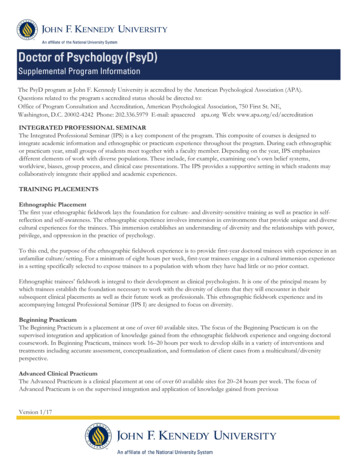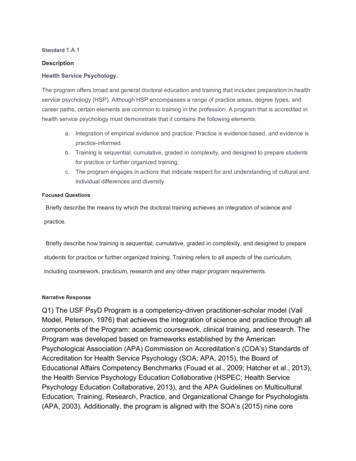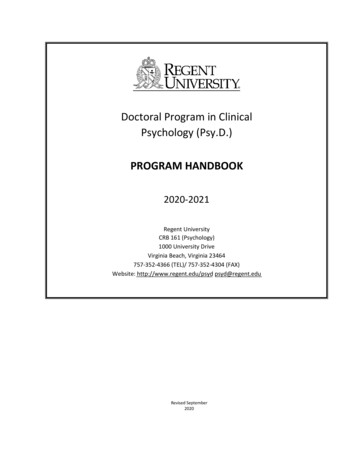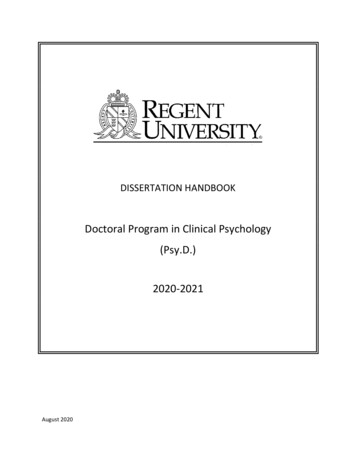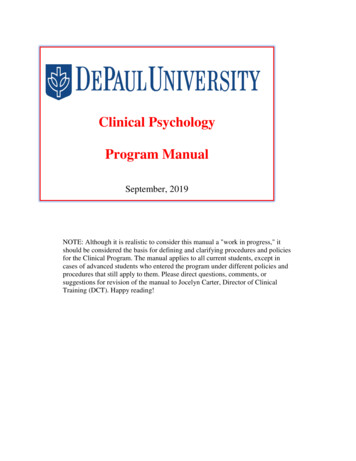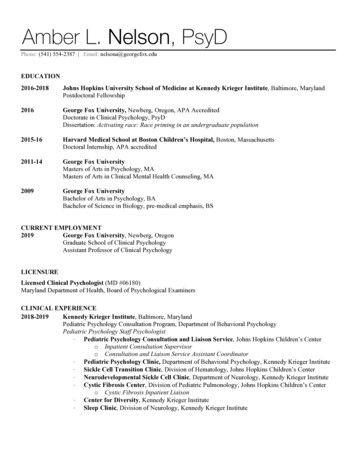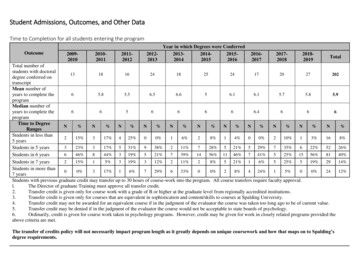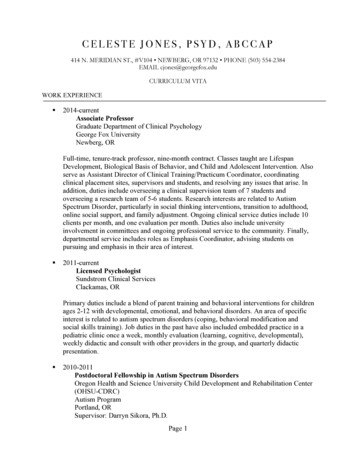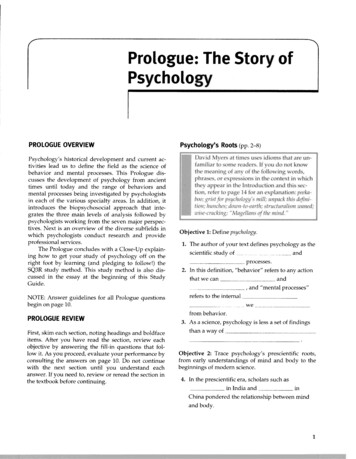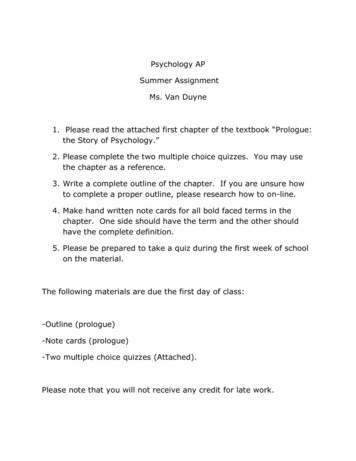
Transcription
PsyD PROGRAM IN CLINICAL PSYCHOLOGYCLINICAL DISSERTATION MANUALRevised March 1, 2019
2INTRODUCTION TO CLINICAL DISSERTATIONThe faculty of Medaille College’s PsyD Program in Clinical Psychology views thedissertation to be an essential component of doctoral education. The clinical dissertationis an original scholarly work whose successful completion demonstrates the student’sability to: formulate a problem, question, or issue of relevance to the professionalpractice of clinical psychology; identify, understand, and apply a method for collecting data intended to addressthe problem, question, or issue under study; analyze, interpret, evaluate, and integrate the findings in a way that providesnew knowledge about—and thereby contributes to solving—the problem,question, or issue under investigation.As an original work of scholarship, the dissertation requires mastery of subject matter;the ability to understand and critically evaluate theoretical, conceptual, and researchliterature; to integrate and reason from knowledge thereby derived; clear, professionalwritten communication; and planning, time management, organization, task execution,and persistence. In its final form, the dissertation should be of publishable quality andcontribute to the body of knowledge in professional psychology. A flowchart providingan overview of the dissertation process may be found in Appendix A.TYPES OF DISSERTATIONS FOR THE PsyD DEGREEIN CLINICAL PSYCHOLOGYAs presented in the list immediately below, and consistent with the diversitycharacterizing dissertations across different PsyD programs in Clinical Psychology, avariety of options are available for the type of clinical dissertation the student mayundertake. Essential characteristics of these different types of dissertation have been welldescribed by a number of programs and as such their descriptions are directly cited. Theorder of this list is not based on the importance or quality of the type of dissertation. Thefundamental criterion in choosing a particular type of dissertation is that it be logicallyand methodologically appropriate for the topic and question(s) the student is interested inaddressing.1.) Empirical Studies: Involve “the collection, analysis, and interpretation of originaldata (broadly defined to include secondary analysis of archival data already available,replications, content analysis, media, etc.) to address a problem of theoretical or practicalinterest” (Antioch University, 2017, p. DH-4)a.) Quantitative: The quantitative dissertation is an empirical study of a topicrelevant to the professional practice of psychology utilizing quantitative researchtechniques. It seeks to make a scholarly contribution to the field using either original datacollected during the course of the dissertation or archival data from a preexisting data set[Type here]
3(i.e., secondary analysis of data). “Examples of methodologies for these types of studiesinclude but are not limited to, group experiments, single case research, quasiexperimental, ex post facto or causal comparative, correlational. With these types ofstudies, it is expected that students will develop specific research questions andhypotheses and will conduct empirical testing of predictions derived from thesehypotheses. Other examples of quantitative research studies include meta-analyses andprogram evaluation/needs assessment [described in greater detail below]” (Rutgers, 2015,p. 7). The sine qua non for the quantitative dissertation is the analysis of numerical data.The majority of material pertinent to this type of dissertation is covered in a "researchmethods" class for conducting quantitative research.b.) Qualitative: A qualitative dissertation is an empirical study that usesinterviewing and other forms of systematic, open-ended inquiry to collect detaileddescriptions of participants’ first-hand experiences in a specific situation of interest; thesein-depth descriptions are analyzed through interpretive methods designed to bring forththematic meanings embedded in participants’ subjective experiences and how theirbehavior is influenced by those meanings. Qualitative methods include, but are far fromlimited to, “interview studies, focus group studies, phenomenological studies,participatory methods, and program evaluation” (Pepperdine University, 2017, p. 3).c.) Mixed Methods: A research investigation containing both quantitative andqualitative elements. A mixed method study creates a rich form of understanding aboutthe phenomenon under study through integrating knowledge yielded by both investigativemodes.2.) Meta-analysis: “Meta-analysis, as its name implies, involves data analysis at a moregeneral level than standard descriptive or inferential statistics. It uses findings acrossstudies, as opposed to responses drawn from individuals, as the data to be analyzed. Afterfollowing the procedures of traditional narrative review with respect to selection of topicand relevant literature, the meta-analyst transforms the findings from each study (t-tests,correlations, F ratios, etc.) into measures of effect size. The next step is to examine thevariance of effects across studies to determine whether the differences observed betweenstudies are greater than that which would be expected from simple sampling variance. Ifthere is evidence of additional variance (note that in fact this is rather uncommon), othercarefully suggested, theoretically relevant moderating variables may be examined, suchas sample characteristics, measures employed, etc. These moderating variables should,for the most part, be chosen and defended prior to the performing of the analysis, lestchoosing a grocery basketful of post hoc hypotheses produce significant findings simplyby capitalizing on chance. On the other hand, the influence of some study characteristicson findings may only be manifest after the data has been gathered (e.g., Donahue, 1985).To perform a meta-analysis, the student needs to learn the analytical procedures unique toit, such as transforming a variety of inferential statistics into a common effect sizemeasure, and some of the basic issues surrounding the technique as a whole. Of greatbenefit, sophisticated software has been developed to simplify the effort involved incalculations, so that the student may focus more attention on interpretation” (Institute forthe Psychological Sciences, 2012, p. 17). Numerous articles centering on quantitative[Type here]
4meta-analysis may be found in the journal Clinical Psychology Review.3.) Systematic Review of the Literature: “According to the Publication Manual of theAmerican Psychological Association (American Psychological Association, 2001):Review articles are critical evaluations of material that has alreadybeen published. By organizing, integrating, and evaluating previouslypublished material, the author of a review article considers the progressof current research toward clarifying a problem. In a sense, a reviewarticle is tutorial in that the author defines and clarifies the problem; summarizes previous investigations in order to inform the readerof the state of current research; identifies relations, contradictions, gaps, and inconsistencies inthe literature; and suggests the next step or steps in solving the problem. (p. 7)Thus writing a literature review involves two tasks: 1) describing work done on a specificarea of research, and 2) evaluating this work. Both the descriptive and evaluativeelements are important parts of the review. Do not simply describe past work withoutevaluating it, and do not just discuss recent theories in an area without both describing thework done to test those theories and discussing each theory’s advantages andinadequacies. Review articles are valuable information sources not only because they citeevery important piece of research in the area surveyed, but also because they compareand evaluate all the key theories in a particular area of research .There are two general approaches to a literature review: Choose an area of research, read all the relevant and most important studies, anddevise a meaningful way to organize the studies. One example of an organizing theme isa conflict or controversy in an area; in this case, publications presenting all sides of thecontroversy should be reviewed. Trace the development of a particular concept over time, concluding with a criticalanalysis of the present state of the question and suggestions for further research”(Roosevelt University, 2013, p. 19).APA publishes a journal, Psychological Bulletin, whose primary mission is topresent articles of precisely this type. The journal Clinical Psychology Reviewalsocontains numerous literature-review articles. Students considering this sort ofdissertationare strongly encouraged to consult these two journals for a host of examples,includingvariations in the form that a systematic literature review may take.4.) Theoretical Studies: “Theoretical studies are closely and carefully reasoned effortstosynthesize existing theory and research [in a specific area pertaining to professional[Type here]
5psychology] in order to propose a new and original way of explaining, organizing orunderstanding [the area of interest]. Theoretical studies should include an extensive,critical review of the existing literature, a proposed model for understanding theliterature,and a discussion of [clinical and research] implications for the field of clinicalpsychology” (California Institute of Integral Studies, p. 14). A different type oftheoretical study may entail a systematic, empirically-based evaluation of alternativetheories in the student’s focal area of interest.It is strongly recommended that students interested in doing a dissertation of this typeconsult the APA journal Psychological Review, which is devoted to articles that makeimportant theoretical contributions to the literature.5.) Program Evaluation: Program evaluation consists of “an empirical study explicitlyintended to support the design, delivery, or impact of a human service program .[Aprogram evaluation study] may include questions pertaining to program utilization,implementation, fine-tuning, and effectiveness. The use of traditional empirical, as wellas action research methods is supported” (Antioch University, p. DH-4)6.) Needs Assessment: A needs assessment is a type of dissertation related to programevaluation that can be carried out either in conjunction with the latter or as a separateproject unto itself. Needs assessment “entails the use of a systematic process fordetermining and addressing the specific needs of an organization, important stakeholderswithin that organization [and/or a specific, well-defined population] . A needsassessment tends to be an integral part of a planning process that can subsequently lead tosome type of improvement in a system or organization [and/or in service delivery]”(Rutgers University, 2014, p. 8)7.) Design of an Innovative Program: This type of project consists of “a design indepth of a program of psychological strategy, methodology or techniques to achievesome goal consistent with contemporary principles of professional psychology. Theprogram developed must demonstrate application of relevant theory, research, andconsideration of similar programs reported in the literature in its design, and must includea detailed plan or guideline for the evaluation of the program developed, even though theevaluation will not be conducted as part of the dissertation” (Rutgers University, 2014, p.DH-4). Programs that may be designed include “treatment interventions, preventionprograms, organization consultations, etc.” (Antioch University, 2017, p. DH-4).8.) Case Study: “A case study involves a comprehensive, systematic, rigorous,qualitative analysis of one or more clinical case studies involving a particular type ofpresenting problem and theoretical approach of clinical interest to the student. Thesestudies involve standardized, quantitative measures of outcome, and sometimesstandardized, quantitative measures of process. For examples of such case studies, seethe open access, online, peer-reviewed journal, Pragmatic Case Studies in � (Rutgers University, 2014, p. 8) and the journalClinical Case Studies (available online through Medaille Libraries).[Type here]
69.) The Relationship Between Psychology and Public Policy. “There are many areas ofpublic policy where psychology might have an impact, either by direct service or throughconsultation based on existing psychological knowledge and practice (e.g., nuclear arms;environmental policy, policies affecting children, mentally ill, elderly, etc.). Dissertationsof this type involve a thorough analysis of the history and rationale for a current policy; arigorous and critical integration of relevant psychological knowledge; and specificrecommendations for policy modification, research, and/or service that might be providedby professional psychologists” (Antioch University, 2017, p. DH-4). Consistent with thegrowing role of psychologists as policy advocates (see American PsychologicalAssociation, 2014; Cohen, Lee, & McIlwraith, 2012; Hill, 2013; vers/advocacy/psychologists.aspx), apolicy advocacy dissertation represents another type of dissertation reflecting andembodying the relationship between psychology and public policy.SELECTING A DISSERTATION CHAIR AND COMMITTEEIt is the student’s responsibility to form a Dissertation Committee, consisting of oneChair and two additional members—although a student’s Committee may include, inaddition to the Chair, up to four additional members. The Chair must be a full-timemember of the Medaille Faculty; in the event that she or he is not a member of the PsyDProgram’s core faculty, at least one core-faculty member from the latter Program mustserve on the Committee.The student’s first step in forming a Dissertation Committee is selecting aCommittee Chair. This is preceded by the student identifying a dissertation topic that sheor he is strongly interested in pursuing, meeting individually with one or more faculty todiscuss this topic and determine the extent of mutual interest in the topic at hand, andbased on information so gathered, identifying a potential faculty member to serve asCommittee Chair. The student asks this faculty member if she or he would serve in thisrole, and this process is repeated until a specific faculty member has agreed to assume therole as the student’s Dissertation Chair. This faculty member completes, signs, and datesthe appropriate section of the Dissertation Committee Form (see Appendix B) certifyingthat she or he has agreed to serve as the student’s Committee Chair.Subsequently, the Chair and student identify and discuss potential individualswho might serve as additional members of the student’s Committee. Additional membersmay be chosen from among (a) other full-time faculty members of the Department ofCounseling and Clinical Psychology, (b) full-time faculty in other Medaille Collegeacademic Departments, and/or (c) professionals from other settings whose areas ofinterest and expertise are clearly pertinent to the student’s dissertation topic. AllCommittee members must hold a doctoral degree in their respective areas of scholarshipand/or practice, along with additional credentials suited to their position (e.g.,professional licensure in the case of a mental health professional). Once the student andChair have collaboratively decided upon who would be the most appropriate individualsto serve as Committee members, the student is responsible for contacting and asking eachsuch individual to serve on her or his Committee. When a potential member hasindicated a willingness to do so, she or he also fills in, signs, and dates the appropriate[Type here]
7section of the Dissertation Committee Form certifying this agreement. When the Chairand all other members of the Committee have completed the Dissertation CommitteeForm, the student submits this form to her or his Chair for filing.In the event that there is a change in the student’s Committee Chair, the new Chair willcomplete, sign, and date the appropriate section of a new Dissertation Committee Formcertifying that she or he has agreed to serve as the student’s Committee Chair.Responsibilities of Chair and Committee MembersCommittee Chair. The Committee Chair serves as the student’s principle mentor,consultant, and advisor throughout the entire dissertation process. Specificresponsibilities include the following: helping the student translate her or his dissertation topic and idea into a specificproject in which all components, separately and as a unified whole, meet the standards ofexcellence in scholarship expected of a clinical dissertation advising the student in the selection of additional dissertation committeemembers advising and supervising the student throughout all phases of preparing andwriting the dissertation proposal and the final dissertation manuscript reading and providing feedback to the student on iterative drafts of thedissertation proposal and the final dissertation approving the penultimate draft of the proposal and prior to this approval, at heror his discretion, having the student distribute this draft to all dissertation committeemembers for their review and feedback ensuring that the student incorporates into the proposal all revisions requested bycommittee members; the Chair may consult with the latter as needed during this process approving the final draft of the dissertation proposal and in turn its distribution toall committee members in preparation for the proposal oral defense meeting helping the student, as needed, in scheduling the proposal defense and finaldissertation defense meetings chairing the student’s proposal oral defense and final dissertation defensemeetings in accord with procedures described below (see Defending the DissertationProposal and Dissertation Oral Defense Meeting, respectively ) ensuring that all required revisions stemming from the proposal defense meetingare incorporated by the student into the final version of the proposal[Type here]
8 when it is determined that all required revisions have been satisfactorilyincorporated, approving the final version of the dissertation proposal; the Chair mayconsult with other Committee Members as needed prior to providing final approval supervising and providing consultation and advisement to the student throughoutall phases of implementing the dissertation proposal (e.g., conducting one’s empiricalstudy, analyzing the data, and interpreting findings; developing the finalizedorganizational structure for presenting one’s systematic review of the literature;discussing findings as these pertain to the questions addressed by the systematic literaturereview) approving the penultimate draft of the final dissertation manuscript and in turn itsdistribution to all dissertation committee members for their review and feedback approving the final draft of the completed dissertation and its distribution to allcommittee members for their review prior to the final dissertation oral defense meeting;the Chair may consult with other Committee Members as needed prior to granting thisapproval if, based on the dissertation oral defense meeting, revisions are required in thefinal dissertation, overseeing their incorporation into the revised draft reading and providing feedback on the revised draft(s) of the final dissertation;the Chair has the discretion to obtain input from Committee Members during this process,including requesting that the student forward any such draft to members of theCommittee approving the final draft of the completed dissertation manuscript providing the student permission to proceed with the additional steps necessaryfor conferral of the PsyD Degree in Clinical Psychology facilitating the resolution of any difficultie
The faculty of Medaille College’s PsyD Program in Clinical Psychology views the dissertation to be an essential component of doctoral education. The clinical dissertation . (Antioch University, 2017, p. DH-4) a.) Quantitative: The quantitative dissertation is an empirical study of a topic
